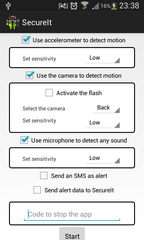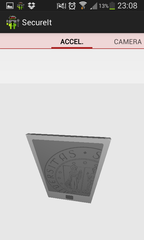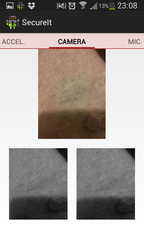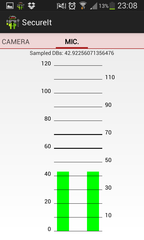Sample Android application that serves as a monitoring service by leveraging on device sensors. Among sensors exploited we report:
-
Accelerometer: used to detect phone's motion
-
Camera: used to detect motion in the phone's surroundings
-
Microphone: used to detected noises in the enviroment
The source code is released open source to be used as a reference (possibly wrong) for your own code. The aim is to help fill in the gap between Javadoc documentation and real code samples.
The application can be built using Android Studio. Building has been tested with Android Studio 1.1.
Application's main view allows the user to set which sensors to use and the corresponding level of sensitivity. A security code must be provided, needed to disable monitoring. A phone number can be set, if any of the sensors is triggered a message is sent to the specified number. Once monitoring is started a paged view gains focus with one fragment for each sensor. Each of these fragments gives a graphical representation of the corresponding sensor state.
The accelerometer page shows an OpenGL animation providing a graphic representation of phone's orientation. Fragment class is defined in me.ziccard.securit.fragment.AccelerometerFragment.
The camera page containes three sub-views:
-
a SurfaceView provides real-time camera-captured images
-
an ImageView shows the last image considered by the motion detector
-
an other ImageView shows the current image being considred by the motion detector
GUI classes are defined in me.ziccard.securit.fragment.CameraFragment
and me.ziccard.securit.Preview.
Motion detection is performed via an asynchronous task defined in me.ziccard.secureit.async that leverages on classes in me.ziccard.secureit.motiondetection.
The microphone page provides a two-bar histogram of sound levels being captured by the mic and is defined in class MicrophoneFragment
Mic data is captured via an asynchronous task (me.ziccard.secureit.async.MicSamplerTask) and the class
me.ziccard.secureit.codec.AudioCodec.
When one of the sensors is triggered (reaches the sensibility threshold) a notifications is sent through the following channels (if enabled).
-
Wifi or Mobile Data: HTTP requests are sent to a server, including periodic updates of device location. Code can be found in package
me.ziccard.secureit.upload -
Bluetooth: messages are sent to all listening nearby devices. Code can be found in packages
me.ziccard.secureit.{bluetooth, messages} -
SMS: a message is sent to the number specified when monitoring started
Notifications are sent through a service running in background that is defined in class me.ziccard.secureit.serviceUploadService.



